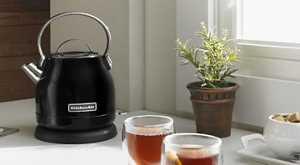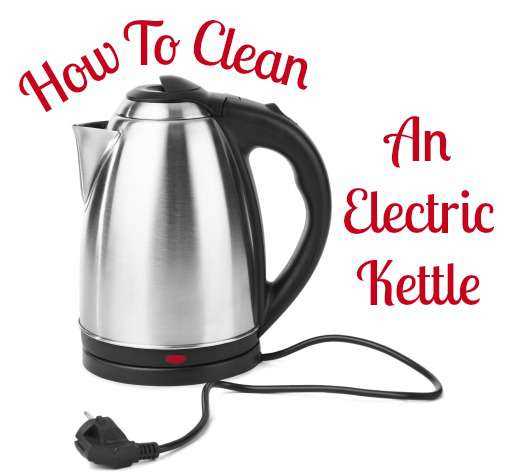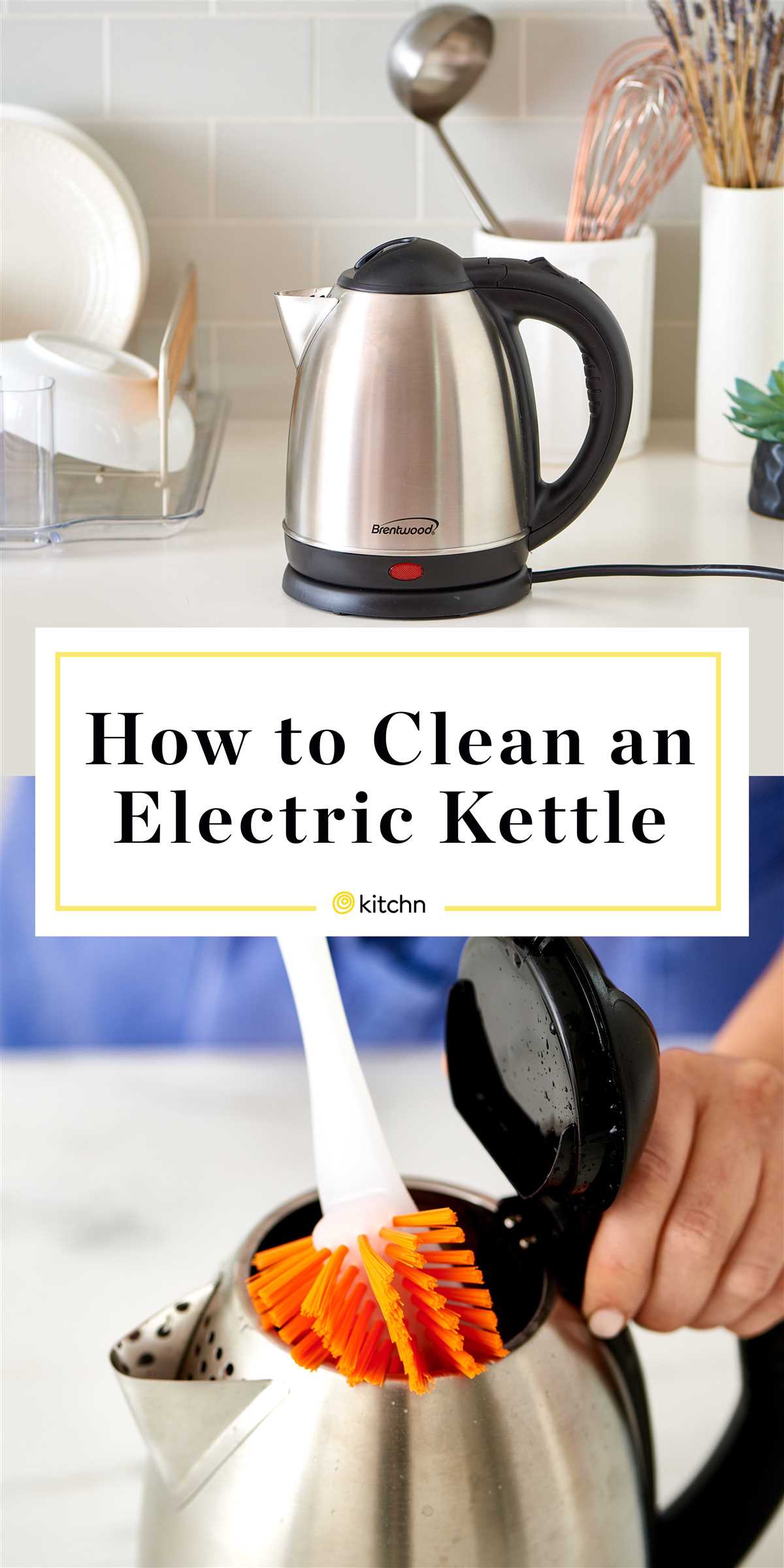
Keeping your electric kettle clean is essential for maintaining its performance and ensuring that it lasts for a long time. Over time, mineral deposits can build up inside the kettle, affecting the taste of your hot beverages and potentially damaging the heating element.
So, how often should you clean an electric kettle? The frequency of cleaning will depend on how often you use it and the quality of your water. If you use your electric kettle daily and have hard water, it is recommended to clean it at least once a month. However, if you have soft water or only use the kettle occasionally, you can clean it every two to three months.
To clean your electric kettle, there are several methods you can use. One common method is to fill the kettle with equal parts water and vinegar, then bring it to a boil. Let the solution sit in the kettle for about 20 minutes, then rinse it out thoroughly. Another method is to use lemon juice instead of vinegar, which can also help remove mineral deposits and leave a fresh scent.
In addition to regular cleaning, it’s important to descale your electric kettle whenever you notice mineral deposits forming. Signs of scale build-up include a white or brown residue on the interior of the kettle or a decrease in water boiling time. To descale your kettle, you can follow the same methods mentioned above using vinegar or lemon juice.
Tip: If you live in an area with hard water, you may want to consider using a water filter or using pre-boiled or filtered water in your electric kettle. This can help reduce the build-up of mineral deposits and prolong the time between cleanings.
By following these cleaning tips and guidelines, you can keep your electric kettle in top condition and enjoy a perfectly brewed cup of tea or coffee every time.
How Often Should You Clean an Electric Kettle?
Maintaining the cleanliness of your electric kettle is important for both its performance and your health. The frequency at which you should clean your electric kettle depends on a variety of factors, including how often you use it and the quality of your water.
General Guidelines
As a general rule, it is recommended to clean your electric kettle at least once a month. This will help to prevent the buildup of mineral deposits and bacteria that can affect the taste and quality of your boiled water.
However, if you live in an area with particularly hard water, or if you use your electric kettle frequently, you may need to clean it more often. Hard water contains high levels of minerals, such as calcium and magnesium, which can leave behind mineral deposits in your kettle over time.
Signs that Your Electric Kettle Needs Cleaning
There are a few signs that indicate your electric kettle may need cleaning:
- The water takes longer to boil
- The water has a strange taste or odor
- There is a layer of mineral deposits or scale inside the kettle
- There are visible stains or discoloration on the exterior of the kettle
If you notice any of these signs, it is important to clean your electric kettle as soon as possible to maintain its performance and ensure the health and safety of your boiled water.
How to Clean an Electric Kettle

Cleaning an electric kettle is a simple process. Here’s a step-by-step guide:
- Unplug the kettle and let it cool completely.
- Remove any loose debris or residue from the kettle, such as tea leaves or coffee grounds.
- Fill the kettle halfway with a solution of equal parts water and white vinegar.
- Boil the vinegar solution in the kettle.
- Let the solution sit in the kettle for about 10-15 minutes to dissolve mineral deposits.
- Empty the kettle and rinse it thoroughly with clean water.
- Wipe the exterior of the kettle with a damp cloth to remove any stains or discoloration.
- Fill the kettle with clean water and boil it once to remove any residual vinegar taste.
- Empty the kettle again and it’s ready to use!
Regularly cleaning your electric kettle will not only extend its lifespan, but also ensure that you have clean and safe water every time you use it. Remember to follow the manufacturer’s instructions for cleaning and maintenance, as some kettles may require special care or cleaning methods.
Importance of Regular Cleaning

Regular cleaning of an electric kettle is essential for maintaining its functionality and ensuring its longevity. Neglecting to clean your kettle can result in several problems, including:
- Build-up of mineral deposits: Over time, minerals from the water you use to boil can accumulate inside the kettle. These deposits, commonly known as limescale, can affect the taste and quality of your drinks. Regular cleaning prevents the build-up of limescale and keeps your kettle free from stubborn stains.
- Reduced efficiency: The accumulation of mineral deposits not only affects the taste but also reduces the efficiency of your electric kettle. The limescale can block the heating element, causing it to take longer to boil water and use more energy. Regular cleaning helps maintain the kettle’s efficiency and prevents unnecessary energy consumption.
- Potential health risks: If the kettle is not cleaned regularly, harmful bacteria or mold may start to grow inside it. These microorganisms can affect your health if ingested through contaminated water. Regular cleaning ensures that your kettle is free from harmful contaminants, providing you with safe and healthy boiling water.
By establishing a regular cleaning routine, you can enjoy fresh-tasting drinks, maintain the efficiency of your electric kettle, and safeguard your health.
Top Tips for Cleaning an Electric Kettle
1. Regularly descale your kettle
One of the most important steps to keep your electric kettle clean is to regularly descale it. Over time, mineral deposits can build up inside the kettle, especially if you have hard water. This can affect the taste of the water and reduce the efficiency of the kettle. To descale your kettle, follow these steps:
- Fill the kettle halfway with equal parts water and white vinegar.
- Boil the mixture.
- Let it sit for about 30 minutes.
- Empty the kettle and rinse thoroughly.
2. Clean the exterior regularly
In addition to descaling the interior, it’s also important to clean the exterior of your electric kettle regularly. This will help to remove any dirt, dust, or grime that may accumulate over time. To clean the exterior, simply wipe it down with a damp cloth or sponge. Avoid using abrasive cleaners or scrub brushes, as they may damage the surface of the kettle.
3. Pay attention to the filter
If your electric kettle has a removable filter, it’s important to clean it regularly as well. The filter prevents any impurities from entering your kettle and affecting the quality of your water. To clean the filter, simply remove it from the kettle and rinse it under running water. You can also use a small brush to remove any stubborn debris.
4. Avoid using harsh chemicals

When cleaning your electric kettle, it’s best to avoid using harsh chemicals or cleaners. Stick to natural cleaning agents, such as white vinegar or lemon juice, which are effective at removing mineral deposits without causing any damage.
5. Store your kettle properly
When you’re not using your electric kettle, make sure to store it in a cool, dry place. Avoid placing it near sources of heat or in direct sunlight, as this can cause the kettle to deteriorate faster. Storing it properly will help to prolong its lifespan and keep it clean.
6. Regularly replace the water
To keep your electric kettle clean and free from any odors, it’s a good idea to regularly replace the water. Standing water can become stagnant and develop a foul smell over time. By emptying and refilling the kettle with fresh water before each use, you’ll ensure that the water is clean and fresh.
7. Check the manufacturer’s instructions
Finally, it’s always a good idea to check the manufacturer’s instructions for specific cleaning recommendations for your electric kettle. Different kettles may have different cleaning requirements, so be sure to follow the guidelines provided to keep your kettle in top condition.
Guidelines for Maintaining Cleanliness
Regular cleaning of your electric kettle is essential to ensure its longevity and performance. Here are some guidelines to help you maintain cleanliness:
1. Clean the exterior

Start by wiping down the exterior of the electric kettle with a damp cloth. This will remove dust and smudges and give it a fresh look.
2. Clean the interior
To clean the interior of the electric kettle, follow these steps:
- Fill the kettle halfway with equal parts water and vinegar.
- Boil the mixture and let it sit for 15-20 minutes.
- Empty the kettle and rinse it thoroughly with clean water.
- For stubborn stains or mineral deposits, scrub the interior with a brush or sponge.
3. Descale the kettle

Descaling is an important step in maintaining an electric kettle. Over time, mineral deposits and limescale can build up, affecting the kettle’s efficiency. To descale the kettle, follow these steps:
- Fill the kettle halfway with water and add a descaling solution or citric acid.
- Boil the mixture and let it sit for 30 minutes to an hour.
- Empty the kettle and rinse it thoroughly with clean water.
- Use a soft cloth or sponge to wipe away any remaining residue.
4. Clean the filter
If your electric kettle has a removable filter, make sure to clean it regularly. Rinse the filter under running water to remove any buildup or debris. If the filter is extremely dirty, you can soak it in warm soapy water and gently scrub it with a soft brush before rinsing it off.
5. Avoid using harsh chemicals
Avoid using harsh chemicals, such as bleach or abrasive cleaners, as they can damage the kettle’s interior or exterior. Stick to mild cleaning solutions like vinegar or citric acid.
6. Dry thoroughly
After cleaning, make sure to dry the electric kettle thoroughly before using it again. This will prevent any moisture from causing rust or other damage.
7. Clean regularly
It is recommended to clean your electric kettle every 1-2 months for regular use. However, if you notice any signs of buildup or strange taste in your water, clean it more frequently.
By following these guidelines, you can ensure that your electric kettle stays clean, hygienic, and functions optimally for a long time.
Common Mistakes to Avoid
When cleaning your electric kettle, it is important to avoid common mistakes that can negatively affect its performance and lifespan. Here are some mistakes to avoid:
- Using abrasive cleaners: Avoid using abrasive cleaners or scouring pads as they can scratch the interior and exterior surfaces of your kettle.
- Skipping regular cleaning: It is essential to clean your electric kettle regularly to prevent mineral deposits from building up. Skipping regular cleaning can lead to reduced efficiency and unpleasant tastes in your beverages.
- Submerging the kettle: Do not submerge your electric kettle in water or any other liquid. This can damage the electrical components and pose a safety risk.
- Using excessive force when descaling: While descaling is necessary to remove mineral deposits, avoid using excessive force or aggressive descaling agents. This can damage the heating element and other parts of the kettle.
- Not rinsing thoroughly: After cleaning or descaling your electric kettle, make sure to rinse it thoroughly to remove any cleaning residue. Residual cleaning agents can leave behind an unpleasant taste in your drinks.
- Ignoring manufacturer’s instructions: Every electric kettle is different, so it is crucial to read and follow the manufacturer’s instructions for cleaning and maintenance. Ignoring these instructions can void the warranty or cause damage to the kettle.
By avoiding these common mistakes, you can ensure that your electric kettle stays clean, efficient, and safe to use for a long time.
FAQ
Why is it important to clean an electric kettle?
It is important to clean an electric kettle regularly to remove mineral buildup and bacteria that can affect the taste of your water and potentially be harmful to your health.
How often should I clean my electric kettle?
You should clean your electric kettle at least once a month, or more frequently if you notice any mineral buildup or strange tastes/smells in your water.
What is the best way to clean an electric kettle?
The best way to clean an electric kettle is to fill it halfway with equal parts water and white vinegar, then bring the mixture to a boil. Let it sit for about 20 minutes, then pour out the solution and rinse the kettle thoroughly with clean water.
Can I use lemon juice instead of vinegar to clean my electric kettle?
Yes, you can use lemon juice instead of vinegar to clean your electric kettle. Simply fill the kettle with water and add a few slices of lemon. Bring the mixture to a boil, let it sit for a while, then pour it out and rinse the kettle with clean water.
What should I do if my electric kettle has stubborn mineral buildup?
If your electric kettle has stubborn mineral buildup, you can try using a mixture of baking soda and water to scrub the inside of the kettle. Alternatively, you can use a descaling solution specifically designed for electric kettles.
Is it safe to clean an electric kettle with bleach?
No, it is not safe to clean an electric kettle with bleach. Bleach is a harsh chemical that can damage the kettle and may leave a harmful residue behind. It is best to stick to natural cleaning methods, such as using vinegar or lemon juice.












